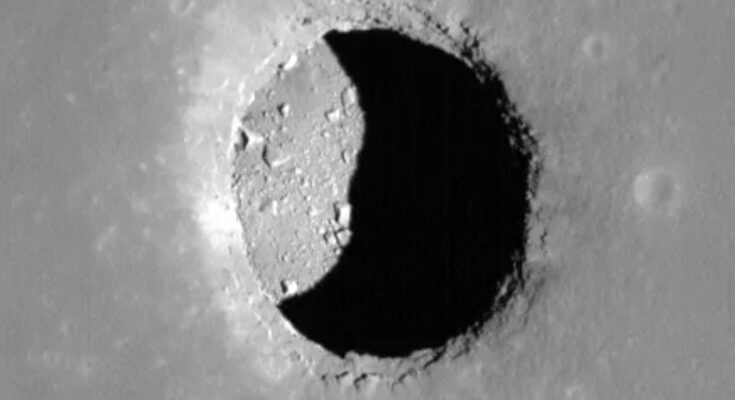The Moon’s surface has over 200 pits where rock and soil have fallen into deep, unknown crevices. A recent study revealed that one of these pits, located in Mare Tranquillitatis, has opened into a hidden underground cave. The cave was formed by a lava tube, now accessible from the Moon’s surface.
Leonardo Carrer, a scientist from the University of Trento in Italy, led the study. He explained that the discovery acts as a “front door” to the massive lunar cave and its hidden interior. The pit offers a unique opportunity for future exploration by humans and robots. It could also help scientists learn more about the Moon’s volcanic past.
Seas of molten rock turned into flat regions
The Moon was once covered in vast seas of molten rock that later cooled, forming the dark, flat regions we see today, called maria. For a long time, scientists have believed that, like Earth, the Moon might also have other volcanic features, such as lava tubes.
Lava tubes are created when a stream of lava cools on the outside, forming a solid shell. Inside, the hot lava keeps flowing, similar to liquid moving through a pipe.
When the lava finally drains out, it leaves behind an empty tunnel. These tunnels could lead to hollow spaces, such as magma chambers or caves, as reported by Live Science.
According to Carrer, there has been plenty of evidence on the Moon’s surface pointing to the possible existence of lunar lava tubes. One strong piece of evidence comes from lunar pits—oval-shaped craters formed not by impacts but by the ground collapsing into an underground space.
Over 200 of these pits have been photographed on the Moon. Scientists believe these pits might act as “skylights,” revealing cave-like tunnels beneath, similar to what happens on Earth when the roof of a cave collapses, exposing it to the surface.
Carrer and his team, including fellow scientist Lorenzo Bruzzone from the University of Trento, aimed to explore if it was possible to map hidden caves on the Moon using radar technology from orbit.
To test this idea, the team used a method known as synthetic aperture radar (SAR) at two cave systems on Earth: one in Lanzarote, Spain and another in Yemen at the Well of Barhout. These locations were chosen because they resemble conditions on the Moon.
Using SAR data, the experts created 3D images of the cave systems near their entrances, helping them comprehend how the technology could be applied to the Moon.
Carrer explained that the cave features they detected from space matched measurements taken by experts on the ground. The team then confidently applied the same technique in the exploration of caves on the Moon.



